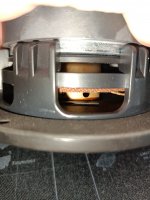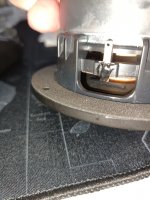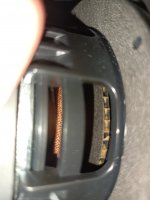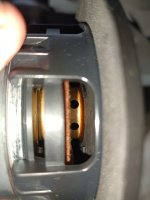Intresting patent! I need to go back and check the measurements on my panels to see if they have these ”problems” and how big they are that is adressed in this patent. I like the idea of smothing the effect of the coincidence frequency by varying either the area mass or bending stiffness.Hello Thomas,
Interesting patent. thank you. In addition to the reinforcement of the voice coil area, it points to facts often reported here :
View attachment 1138136
View attachment 1138138
This patent refers to another interesting one (WO2000015000A1)for a variable thickness panel. In the advantages of non constant thickness:
So some smoothing effect is expected.
- spreading of the coincidence frequency over a range
- adaptation to the edges impedance
The material in the example is a Rohacell core with a variable thickness with glass mat skins.
Christian
But as with all NXT patent they try to cover everything by including all possible variants without stating which one is the best…for example in this patent: stiffer in the center, stiffer at the edges, stiffer non-centrical and many more variants...so there is a bit of guessing and experimentation needed.
I have earlier noticed that nxt is using rohacell as core material. I’m contemplating evaluating this as an alternative to long grain balsa that I’m using today. Going forward I will test cross grained balsa, rohacell and 3d printed honeycomb (this will allow for variation in thickness and area density).
Rohacell compressive and shear strength compared to xps (I have no data for balsa…).
Thomas
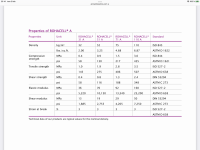
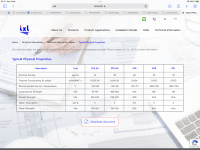
Mudding the water... 🙂But as with all NXT patent they try to cover everything by including all possible variants without stating which one is the best
Like I said before NXT/Tectonic catered to the Pro/live audio industry instead of the Audiophile market.In the last few weeks I found that the DML500 type had been tested upon thoroughly, as early as 2013 by some people and had been discarded as they need the help of a tweeter and a subwoofer. (All kinds of panel material had been used for the testing.)
DML500 and it's variants need crossovers.
View attachment 1138115
Tectonic DML products are more useful in large buildings, such as conference halls, churches, stadiums, airport foyers, gymnasiums etc, where the HF and LF is not really desired. Tectonic Audio Labs, as the surviving successor/heir to NXT/HiWave, practically don't advertise those DML speakers for the general public.
So, while it is quite interesting to read NXT connected patents/documents (#9,094), they don't really direct you to the right direction in making a full-range DML, or at least. Tectonic hadn't produced that specific exciter yet, one of the reasons why NXT and HiWave failed, and why Tectonic emphasises practically on the BMR technology -- you open the Tectonic website, you are shown BMRs, directing you away from the DMLs, an advertising trick. And, why the scientists and engineers from NXT, who are still with Tectonic, concentrate mostly in other areas, rather than in the DM technology. It is stuck, more or less where it was in 2013.
So, my interest moved to those, who actually make saleable, practically Hi-End, tested by many, bought by many paying thousands of euros, DMLs (#9,101). There are a few products to study, a few documents to re-read, and few questions to ask. Certain trade secrets, of course, will not be disclosed, but...
So, time is not anymore a factor. Best follow those, who had succeeded.
Well, some had been digging in the wrong plot for quite a few years. 🙂
Those with "first principles, science-based understanding" can have a go at this work, >> Spin-orbit interactions of transverse sound by Shubo Wang of Department of Physics, City University of Hong Kong in 2021. Remember, who found that phenomenon before him? A whole two decades ago! Or, maybe even before that, "Extraneous Frequencies Generated in Air Carrying Intense Sound Waves" by A. L. Thuras, R. T. Jenkins, H. T. O'Neil, published in 1935.
Strange that the ancient native drummers knew that too... 🙂
Strange too that the BMR membrane itself haven't grown more than 100mm in diameter (from the edge of the surround to the other edge). By the way, what's a BMR? 🙂 (#8,959)
An advertising trick to steer people away from DML's? BMR is there newest/latest technology so they are going to promote it, its not a trick. lol
Hmmmm I remember awhile back someone saying that one should follow patents/designs that actually achieved/accomplished in building a good sounding DML panel? I forget his name it started with a DMB something? 😉
Yes you been digging in the wrong plot for years thats why you aint never struck oil/gold yet. 🤣
When people ignore my advice, it does not effect me one bit it only effects those who ignore it. All I can say is "I TOLD YOU SO".😆🤣
There is a reason why BMR membrane hasnt grown more then 100mm in diameter. What is a BMR? Balanced Mode Radiator. Spedge has been talking about using weights forever, its nothing new. 🙄
For someone that is new here, what is the reason?There is a reason why BMR membrane hasnt grown more then 100mm in diameter. What is a BMR? Balanced Mode Radiator. Spedge has been talking about using weights forever, its nothing new. 🙄
Thomas
You already forgot that you posted the same completely irrelevant paper from your other account? 🤣Those with "first principles, science-based understanding" can have a go at this work,
At least the other guy seems to be taking a holiday, so you dont get confused talking to yourself.
Its basic physics. There is a reason certain drivers are made a certain SIZE. For example why are most tweeters around 1-2inches? Why are midranges 3-4inchs? Why are midbass 5-8inches? Why are woofers/subwoofers 10inches and up? Each sized driver will have an ideal frequency response.
This is why I stress you cant just make your panels any size you want as even with DML's have to abide by certain physics when it comes to size. This is the reason Spedge and I also like smaller DML panels because smaller panels will focus the high frequencies.
If you look at full range drivers most of them are on the smaller side. Ever wonder why they are usually in the 3-6inch size?
The larger the surface area becomes the more dispersed/diffused the highs will become making it sound less prominent.
When (Eucy?) put a small dome shape on the panel it increased clarity because the highs will be more focused and more prominent. The small dome shape will act as a "whizzer" cone focusing the high frequencies.
BMR's are advertised as full range. The larger the diaphragm becomes the more the high frequencies will suffer and would no longer be considered full range but instead a midwoofer.
To many people are over analyzing this technology and making things more complicated then it has to be as DML technology is nothing new its been around since the 50's or earlier.
DML's are more similar to conventional cone drivers then one might think.
This is why I stress you cant just make your panels any size you want as even with DML's have to abide by certain physics when it comes to size. This is the reason Spedge and I also like smaller DML panels because smaller panels will focus the high frequencies.
If you look at full range drivers most of them are on the smaller side. Ever wonder why they are usually in the 3-6inch size?
The larger the surface area becomes the more dispersed/diffused the highs will become making it sound less prominent.
When (Eucy?) put a small dome shape on the panel it increased clarity because the highs will be more focused and more prominent. The small dome shape will act as a "whizzer" cone focusing the high frequencies.
BMR's are advertised as full range. The larger the diaphragm becomes the more the high frequencies will suffer and would no longer be considered full range but instead a midwoofer.
To many people are over analyzing this technology and making things more complicated then it has to be as DML technology is nothing new its been around since the 50's or earlier.
DML's are more similar to conventional cone drivers then one might think.
Man there's some complicated stuff going on in this and previous posts of yours ---chopped up scanspeak driver, tortuous cutouts, chambers, etc etc. I also note in the above photos that the rear of the panel has been totally covered by polyfoam to damp it.Sound and design are equally important to me. I will be in Munich High End show this May to touch and feel, get inspired.
A lot of things I had to learn with this hobby, like woodworking, 2d Cad drawing, CNC wood cutting, hand tools, material science, epoxy resin vacum lamination, acoustics, speaker design programs, industrial design and many more.
More things to learn or need to create contacts who can help me with measurements, painted surface finish, aluminium cnc milling, 3d printing, 3D CAD drawing, active filters, passive filters, digital EQ.
Test the panels on Klipell nearfield scanner would be valuable.
I use Lyngdorf amplifier with RoomPerfect wich helps to test the panels.
Some explanation of the project/s design, aims and results would be welcomed
Eucy
Some pics and details of the Dayton TEBM65C20F BMR
The diaphragm appears to be a paper/Nomex/paper sandwich about 2mm thick. In accordance with their BMR info sheet, the edge of the diaphragm does appear to extend approx to just shy of the centre of the roll of the surround. That matches the calculated piston diameter of just under 69mm.
What's not in accordance with their blurb are the ring masses. Instead of ring masses we have three straight pieces of added mass which I would assume must:
a) cross node boundaries
b) create unevenness in response
The exigencies of mass production I guess
The X max (p-p) figure of 10mm seems a bit optimistic? ... Maybe it means +/- 5 ??
The voice coil former extension length is about 18mm, vented between the diaphragm and spider, the diameter of which is about 70mm... Obviously designed for long throw.
Eucy
The diaphragm appears to be a paper/Nomex/paper sandwich about 2mm thick. In accordance with their BMR info sheet, the edge of the diaphragm does appear to extend approx to just shy of the centre of the roll of the surround. That matches the calculated piston diameter of just under 69mm.
What's not in accordance with their blurb are the ring masses. Instead of ring masses we have three straight pieces of added mass which I would assume must:
a) cross node boundaries
b) create unevenness in response
The exigencies of mass production I guess
The X max (p-p) figure of 10mm seems a bit optimistic? ... Maybe it means +/- 5 ??
The voice coil former extension length is about 18mm, vented between the diaphragm and spider, the diameter of which is about 70mm... Obviously designed for long throw.
Eucy
Attachments
What exactly do you mean by "focussing the high frequencies"?ts basic physics. There is a reason certain drivers are made a certain SIZE. For example why are most tweeters around 1-2inches? Why are midranges 3-4inchs? Why are midbass 5-8inches? Why are woofers/subwoofers 10inches and up? Each sized driver will have an ideal frequency response.
This is why I stress you cant just make your panels any size you want as even with DML's have to abide by certain physics when it comes to size. This is the reason Spedge and I also like smaller DML panels because smaller panels will focus the high frequencies.
If you look at full range drivers most of them are on the smaller side. Ever wonder why they are usually in the 3-6inch size?
The larger the surface area becomes the more dispersed/diffused the highs will become making it sound less prominent.
The usual explanation for why pistonic drivers are of different sizes for different frequencies is that lows require displacement of a lot of air, and hence require large pistons (cones), but the compromise is that such large cones cause high frequencies to "beam" (focus?) too much, that is, to have too little SPL off axis. Hence, for high frequencies, designers crossover to smaller and smaller pistons (as the requirement for large displacement decreases) in order to avoid beaming (focussing?) the SPL too much.
But you seem to be saying that the problem with large drivers is that they focus too little, rather than too much. So you've lost me.
Eric
Last edited:
Disconnecting either of the wires connected to it would stop that pesky pistonic motion of the voice coil.Do you have a possibility to stop that pistonic motion of the voice coil?
Eric
That would indeed be tricky. To transfer the vibrations to the panel, without making the panel move.The thing is, the voice coil shouldn't move the panel, the exciter must only transfer the vibrations. This is the tricky part. Have a look at all those patents
Please tell me, can you provide a quote from any of those patents which implies that?
I thought vibrating was a type of moving.
Eric
Not at all.Anything against Himalayan, Trans-Tibetan languages? Like in the '60s?
But gibberish calls for a taunting.
Please look up Dunning-Kruger.
Last edited:
Whizzer cone.What exactly do you mean by "focussing the high frequencies"?
The usual explanation for why pistonic drivers are of different sizes for different frequencies is that lows require displacement of a lot of air, and hence require large pistons (cones), but the compromise is that such large cones cause high frequencies to "beam" (focus?) too much, that is, to have too little SPL off axis. Hence, for high frequencies, designers crossover to smaller and smaller pistons (as the requirement for large displacement decreases) in order to avoid beaming (focussing?) the SPL too much.
But you seem to be saying that the problem with large drivers is that they focus too little, rather than too much. So you've lost me.
Eric
Have look at the 2nd and 3rd image in this post #7,321. Do you think that heavy 6mm glass sheet (~4kg) lying on the 20mm EPS sheet allowed those tiny exciters to jump about? Vibrations are vibrations... 🙂That would indeed be tricky. To transfer the vibrations to the panel, without making the panel move.
-----
I thought vibrating was a type of moving.
You thought wrong.
And awaaaay we go...I thought vibrating was a type of moving
Ha! Why didnt I think of that! Vibrations are vibrations. Now thats deep...Vibrations are vibrations
How deep?🙂Ha! Why didnt I think of that! Vibrations are vibrations. Now thats deep...
Oh, didn't know that he is Dr. Graham Bank incognito here. Good that you told us! 🙂There is a reason why BMR membrane hasnt grown more then 100mm in diameter. What is a BMR? Balanced Mode Radiator. Spedge has been talking about using weights forever, its nothing new.
So, you recognise yourself? Excellent! 🙂Please look up Dunning-Kruger.
- Home
- Loudspeakers
- Full Range
- A Study of DMLs as a Full Range Speaker
